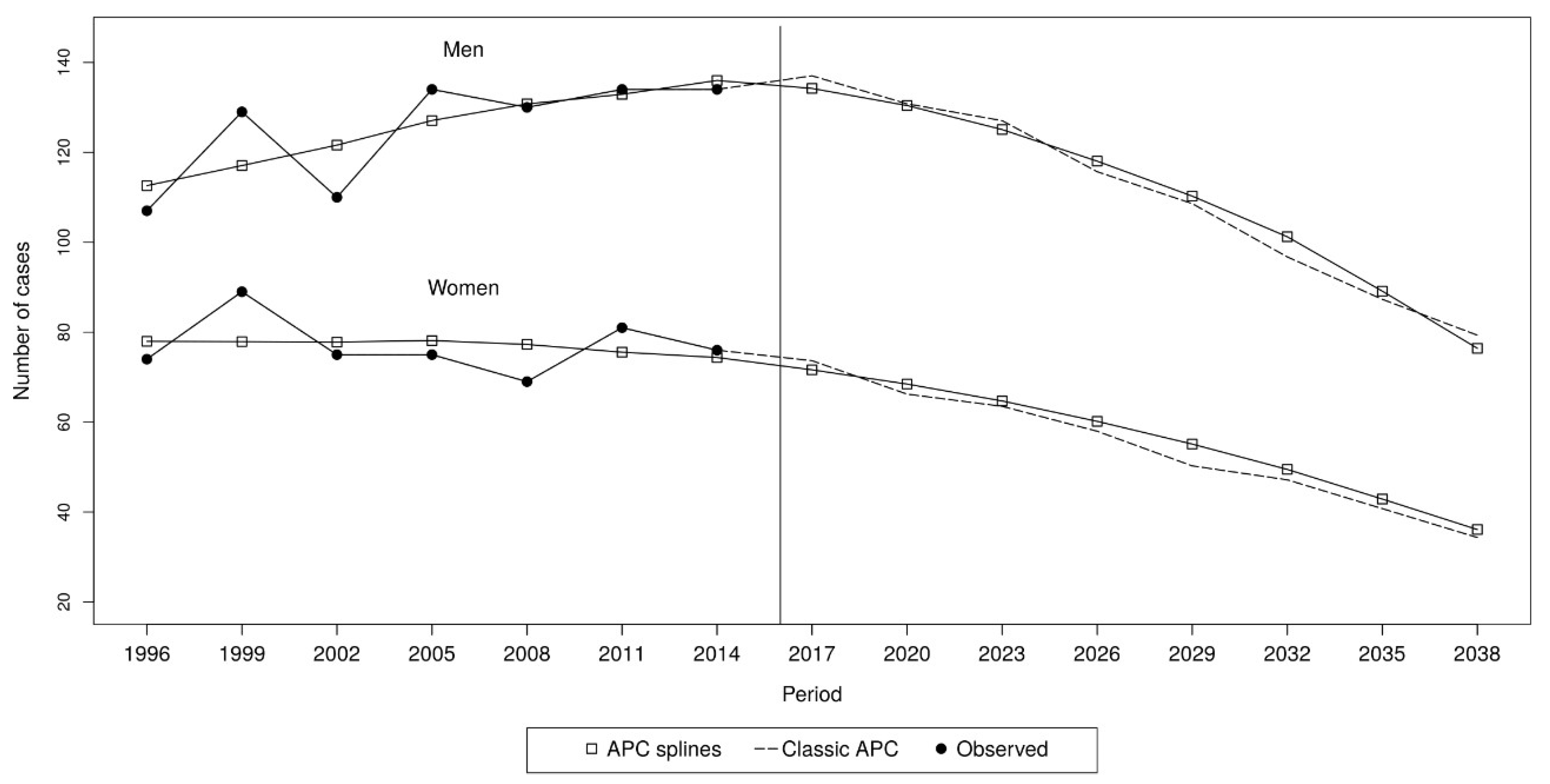Forecast of Malignant Peritoneal Mesothelioma Mortality in Italy up to 2040
Abstract
1. Introduction
2. Material and Methods
2.1. Data Source
2.2. Statistical Analysis
3. Results
4. Discussion
5. Conclusions
Supplementary Materials
Author Contributions
Funding
Institutional Review Board Statement
Informed Consent Statement
Consent for Publication
Data Availability Statement
Conflicts of Interest
Appendix A. R Code
# Load library
library(apc)
library(Epi)
# Load data frame with age, period, cases and person-years
data = read.csv(data.csv)
# Define a range of degree of freedom
dof = 2:5
# Create AIC vector
aic_vec = c()
# Create grid of degree of freedom
par = as.matrix(expand.grid(rep(list(gdl.M), 3)))
# Loop to search for best model in term of AIC
for(i in 1:nrow(par)){
# fit sequentially (parm = "AC-P") an apc splines (natural cubic splines: model = “ns”)
model_fit = apc.fit(data, dist = "poisson", model = "ns", parm = "AC-P",
npar = as.vector(par[i, ]))
aic_vec = c(aic_vec, model_fit$Model$aic)
}
# optimal model
model_best = apc.fit(data, dist = "poisson", model = "ns", parm = "AC-P", npar = as.vector(par[which.min(aic_vec), ]))
References
- Carbone, M.; Adusumilli, P.S.; Alexander, H.R., Jr.; Baas, P.; Bardelli, F.; Bononi, A.; Bueno, R.; Felley-Bosco, E.; Galateau-Salle, F.; Jablons, D.; et al. Mesothelioma: Scientific clues for prevention, diagnosis, and therapy. CA Cancer J. Clin. 2019, 69, 402–429. [Google Scholar] [CrossRef] [PubMed]
- Delgermaa, V.; Takahashi, K.; Park, E.K.; Le, G.V.; Hara, T.; Sorahan, T. Global mesothelioma deaths reported to the World Health Organization between 1994 and 2008. Bull. World Health Organ. 2011, 89, 716–724. [Google Scholar] [CrossRef] [PubMed]
- Boffetta, P. Epidemiology of peritoneal mesothelioma: A review. Ann. Oncol. 2007, 18, 985–990. [Google Scholar] [CrossRef] [PubMed]
- The Italian Workers Compensation Authority (INAIL). 6th Report of Italian National Mesothelioma Registry. 2018. Available online: https://www.inail.it/cs/internet/docs/alg-pubbl-registro-nazionale-mesoteliomi-6-rapporto.pdf (accessed on 10 September 2020).
- Conti, S.; Minelli, G.; Ascoli, V.; Marinaccio, A.; Bonafede, M.; Manno, V.; Crialesi, R.; Straif, K. Peritoneal mesothelioma in Italy: Trends and geography of mortality and incidence. Am. J. Ind. Med. 2015, 58, 1050–1058. [Google Scholar] [CrossRef] [PubMed]
- Carstensen, B. Age–period–cohort models for the Lexis diagram. Stat. Med. 2007, 26, 3018–3045. [Google Scholar] [CrossRef] [PubMed]
- Oddone, E.; Bollon, J.; Nava, C.R.; Bugani, M.; Consonni, D.; Marinaccio, A.; Magnani, C.; Barone-Adesi, F. Predictions of mortality from pleural mesothelioma in Italy after the ban of asbestos use. Int. J. Environ. Res. Public Health 2020, 17, 607. [Google Scholar] [CrossRef] [PubMed]
- Luberto, F.; Ferrante, D.; Silvestri, S.; Angelini, A.; Cuccaro, F.; Nannavecchia, A.M.; Oddone, E.; Vicentini, M.; Barone-Adesi, F.; Cena, T.; et al. Cumulative asbestos exposure and mortality from asbestos related diseases in a pooled analysis of 21 asbestos cement cohorts in Italy. Environ. Health 2019, 18, 71. [Google Scholar] [CrossRef] [PubMed]
- Consonni, D.; Calvi, C.; De Matteis, S.; Mirabelli, D.; Landi, M.T.; Caporaso, N.E.; Peters, S.; Vermeulen, R.; Kromhout, H.; Dallari, B.; et al. Peritoneal mesothelioma and asbestos exposure: A population-based case-control study in Lombardy, Italy. Occup. Environ. Med. 2019, 76, 545–553. [Google Scholar] [CrossRef] [PubMed]
- Zona, A.; Fazzo, L.; Minelli, G.; De Santis, M.; Bruno, C.; Conti, S.; Comba, P. Peritoneal mesothelioma mortality in Italy: Spatial analysis and search for asbestos exposure sources. Cancer Epidemiol. 2019, 60, 162–167. [Google Scholar] [CrossRef] [PubMed]
- Barone-Adesi, F.; Richiardi, L.; Merletti, F. Population attributable risk for occupational cancer in Italy. Int. J. Occup. Environ. Health 2005, 11, 23–31. [Google Scholar] [CrossRef] [PubMed]
- Soeberg, M.J.; Leigh, J.; Driscoll, T.; Armstrong, B.; Young, J.M.; van Zandwijk, N. Incidence and survival trends for malignant pleural and peritoneal mesothelioma, Australia, 1982–2009. Occup. Environ. Med. 2016, 73, 187–194. [Google Scholar] [CrossRef] [PubMed]

Publisher’s Note: MDPI stays neutral with regard to jurisdictional claims in published maps and institutional affiliations. |
© 2020 by the authors. Licensee MDPI, Basel, Switzerland. This article is an open access article distributed under the terms and conditions of the Creative Commons Attribution (CC BY) license (http://creativecommons.org/licenses/by/4.0/).
Share and Cite
Oddone, E.; Bollon, J.; Nava, C.R.; Minelli, G.; Imbriani, M.; Consonni, D.; Marinaccio, A.; Magnani, C.; Barone-Adesi, F. Forecast of Malignant Peritoneal Mesothelioma Mortality in Italy up to 2040. Int. J. Environ. Res. Public Health 2021, 18, 160. https://doi.org/10.3390/ijerph18010160
Oddone E, Bollon J, Nava CR, Minelli G, Imbriani M, Consonni D, Marinaccio A, Magnani C, Barone-Adesi F. Forecast of Malignant Peritoneal Mesothelioma Mortality in Italy up to 2040. International Journal of Environmental Research and Public Health. 2021; 18(1):160. https://doi.org/10.3390/ijerph18010160
Chicago/Turabian StyleOddone, Enrico, Jordy Bollon, Consuelo Rubina Nava, Giada Minelli, Marcello Imbriani, Dario Consonni, Alessandro Marinaccio, Corrado Magnani, and Francesco Barone-Adesi. 2021. "Forecast of Malignant Peritoneal Mesothelioma Mortality in Italy up to 2040" International Journal of Environmental Research and Public Health 18, no. 1: 160. https://doi.org/10.3390/ijerph18010160
APA StyleOddone, E., Bollon, J., Nava, C. R., Minelli, G., Imbriani, M., Consonni, D., Marinaccio, A., Magnani, C., & Barone-Adesi, F. (2021). Forecast of Malignant Peritoneal Mesothelioma Mortality in Italy up to 2040. International Journal of Environmental Research and Public Health, 18(1), 160. https://doi.org/10.3390/ijerph18010160










